Whether you want to climb up mountains, eat grilled meat and wash it down with a cold beer at a streetside bar, bargain in jam-packed markets, walk in the forest, hang out at the beach, prowl around colonial ruins, or evoke memories of that time in Europe at a massive cathedral – you can do it in Ivory Coast.
This Travel Guide follows the route we travelled in Ivory Coast (Cote d’Ivoire), and is a guide to the places we visited and the things we saw and did along the way. You’ll find ideas and advice for getting around the country, and some general practical information as well.
Is Ivory Coast Safe?
Visas
What to Expect (Or What Not to Expect)
Arriving from Liberia by Land
Man
Yammasoukro
Abidjan
Grand Bassam
Packing List
Is Ivory Coast Safe?
The civil war ended in 2011 and Ivory Coast is generally considered to be a safe destination since then. But, consulting your own government’s travel advice for any country is a good idea. You should be alert, and know of any potentially ‘no-go’ areas. It’s worth noting that many/most foreign governments advise against all non-essential travel in Ivory Coast to within 20-50 km of the Liberian border, due to an unstable security situation and the presence of armed militias nearby. Crossing the border or visiting some places in the vicinity (like Man, and Tai National Park) will take you into this area. There hasn’t been any violence near the border since 2015, but doing some research, asking around about the latest situation, and checking what your own government has to say before you set off is a good idea (at the very least, in case your travel insurance is impacted by what’s considered a ‘high-risk’ zone).
Like many countries in this part of the world, your biggest problem by far is the roads (and the vehicles you’ll be in on them).
We didn’t encounter any annoying, persistent or threatening touts or run into any attempted scams. That’s not to say those things don’t exist, but that they are not as widespread as in heavily-touristed countries.
Swimming in the ocean is dangerous due to strong undertows.
Just be sensible: watch out on deserted beaches, even during the day. Don’t walk around empty neighborhoods in Abidjan after dark. Get your accommodation to arrange a taxi for you if you need to go out at night. There’s a good chance you’ll be carrying larger amounts of cash – split it up. When we arrive some place new, we ask the owner or manager at our guesthouse for advice about the area or if there is anything we should be aware of.
Visas
You need a visa for Ivory Coast and getting it on arrival is not possible, you have to bring it with you. You can:
- apply and get it at home, if you have an Ivorian Consulate there (or you can send your passport and application to the nearest Ivorian Consulate who handles things for your country). Or,
- pick it up at an Ivorian Embassy/Consulate in a neighboring country. When you’re planning to pick up visas on the way, make sure you check how long it will take. It’s often just a few days. But it can also be longer than that…and you’ll be sitting in an African city, waiting.
In this case we picked up our visas in Monrovia, Liberia.
Getting an Ivory Coast Visa in Monrovia
Getting the visa in Monrovia was/is quick and easy. The Ivory Coast Embassy in Liberia is located in Monrovia on Warner Street, between 17th and 18th street.
Apparently many Ivorian Embassies require you to fill out the application form online first at www.snedai.com. Then, you book an appointment with the Embassy you’re using, go in and pay and hand over your documentation. At the Embassy in Monrovia this was not the case – we just showed up – but things do change all the time so it doesn’t hurt to check.
We showed up first thing in the morning, asked to apply for the visa, and the receptionist gave us forms to fill out. Then we waited a while until the consular officer was available, and we submitted everything. They will keep your passport for the duration of the process – about 3 days, so make sure you have copies of your passport photo page and your Liberian visa to keep on you in the meantime. We paid and got receipts. Our single entry 3 month tourist visas cost about 55 USD each. I believe you can pay in either USD or CFA (Ivorian currency), if you have it.
We went back on the date and time they specified, waited for a few minutes and got our passports back with the new visa inside.
In general you will need to provide (at least):
- your passport with 6 months validity beyond your intended stay, and a copy of the photo page
- a passport photo
- the form, downloaded/picked up at the Embassy and filled out
- proof of your yellow fever vaccination
No flight bookings were required, as we told them we planned to enter Ivory Coast by land from Liberia.
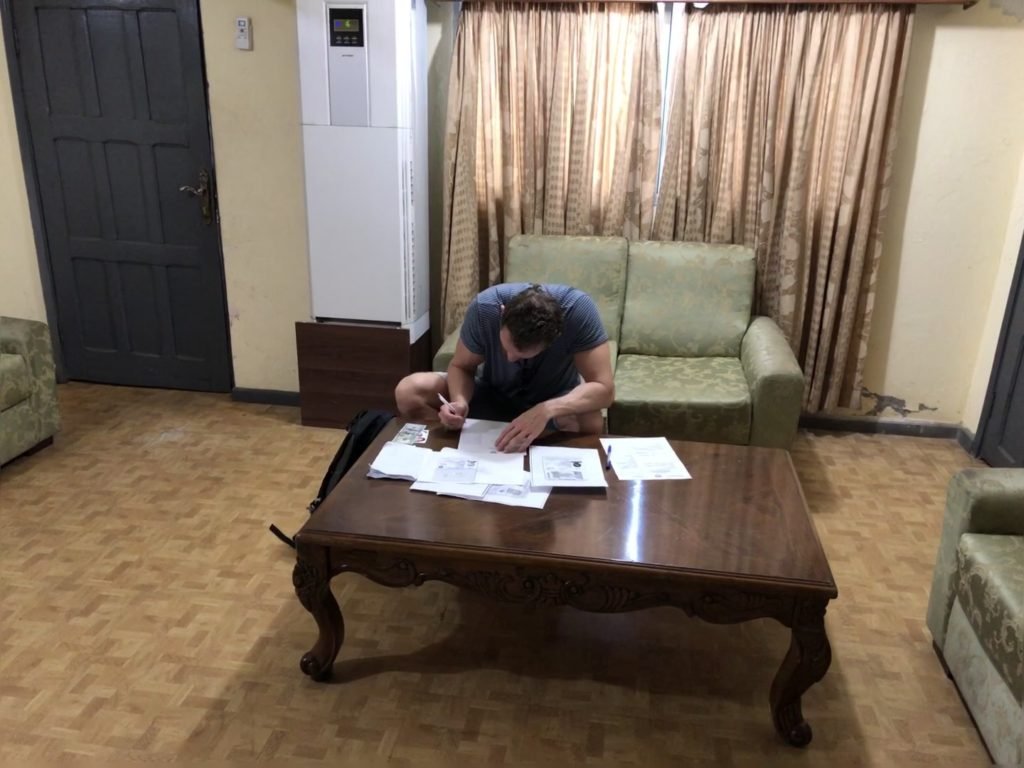
What to Expect (Or What Not to Expect)
Ivory Coast is ‘relatively easy’ to get around. The infrastructure and facilities for tourism are developed to higher standards than in most of the neighboring countries, as the locals travel and holiday in their own country quite a bit. Still, there is not exactly a lot of tourism in Ivory Coast – and most of it seems to be concentrated along the coast, for example at Grand Bassam, where you’ll find a lot of French visitors. Do not expect a travelers’ scene: there isn’t one, and you should not count on meeting other travelers or making friends to travel/share costs with. As usual in the region, much of the tourism that there is, is just that – a little bit of organised tourism geared to groups more so than to independent travelers.
In general, travel in West Africa is significantly harder than in other parts of the continent – for example, it’s not at all like Southern Africa. It’s less developed, it’s rougher, there is much less tourism (in some cases almost none), things go wrong, there isn’t a lot in the way of ‘amenities’ that make a holiday go smoothly. Overall, I wouldn’t recommend independent overland travel in Ivory Coast for your very first trip to Africa.
Keeping in Touch
Most hotels and guestshouses will/should have wifi and you’ll be able to get online. Some restaurants and cafes in cities will have it too, but in general it’s slow or unreliable. You can of course buy a local SIM card and use data on the road.
Also, since wifi is unreliable and travel information about Ivory Coast is limited anyway, do your research in advance, or at least find out anything you need to know before leaving for a remote area. Have a plan in your mind about how you’ll get from one place to the next. Bring a guidebook or screenshot any important info (from this guide, for example:)).
If you haven’t already got WhatsApp, install it. Everyone uses it and it’s handy for planning with guides and drivers and so on.
Security, Checkpoints and Police
There are a lot of checkpoints on the road, especially when coming from the border with Liberia. You’ll have to show your passport and sometimes get out of the vehicle to talk to the police. Always carry your passport or at least a copy of both the photo page and the visa page. Don’t give the police an opportunity to hassle you.
Transportation
Long distance bus travel goes fairly smoothly around here, except when it doesn’t (but getting there is half the fun). There is a mix of pretty decent transport and less decent transport.
Most roads and vehicles are badly maintained although some are better than others. Vehicles are usually overcrowded as well. You can forget about seatbelts in share taxis. Drivers are often reckless. Because of all this, you should stay off the roads after dark.
Transport comes in different forms:
- Shared-taxis and regular taxis. Shared-taxis run like buses around a town or city. You can flag one going your way and tell him where you want to go (or the general vicinity, like a landmark or an intersection). If he’s going that way you can pay for a seat. The prices are standard per seat, once you know the rate you don’t even have to ask, just hand it over before you hop out. He’ll stop along the way to let people in and out and he won’t take you door to door. Regular taxis are usually a different colour, and you need to haggle the price before getting in. Or, you can agree with the driver to pay for all the seats in a shared-taxi making it private. Taxi drivers will almost definitely get lost. Follow your route on Maps.me and you’ll probably end up directing him. He will likely also stop and ask directions from passersby. At night, if you need to go out, book a private taxi through your accommodation.
- Motos. Motorcycle taxis – we use these a lot, both for short distances in small towns which don’t have regular taxis, and longer distances in remote areas. We have started to travel with proper motorcycle helmets we bring from home as we’ve rarely, probably never, seen a reliable one available to borrow or hire.
- Minibuses (called gbakas). For shorter distances between towns that big buses don’t run. They are usually overcrowded to say the least and so tightly packed, badly driven and poorly maintained as to be a bit frightening sometimes. Take big buses wherever you have the option.
- Buses. There are several companies running big, air-con buses for long distance trips. We used the company called UTB. The buses are very cheap and comfortable, although there is usually an extra seat (so three on one side, two on the other) per row. They run on a loose schedule but we never left even close to on time. You’ll probably have to pay for luggage – if you get a receipt and the clerk records the amount in a giant notebook, then it’s official. Most towns have one or more bus stations – go a day in advance to see the ‘schedule’ and get a rough idea of when to show up (earlier is best). We bought tickets the day of.
In addition to packing out buses with passengers and luggage, there is almost always a goat or two along for the ride.
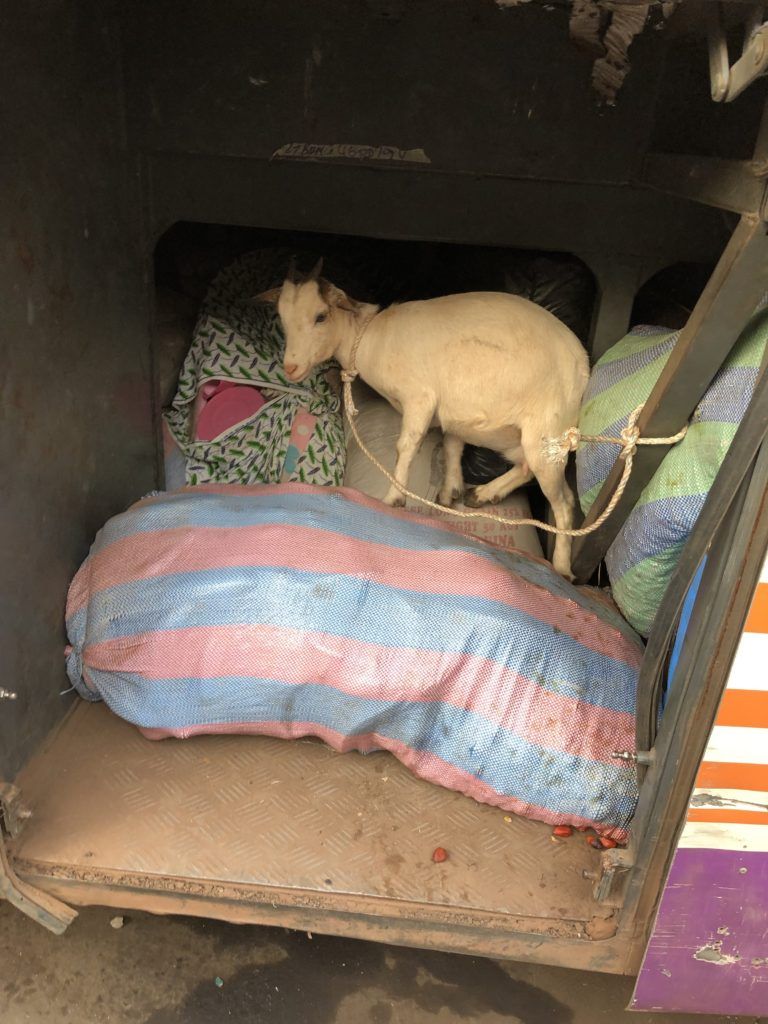
Accommodation
The hostel-concept doesn’t exist and there aren’t a lot of nice small guesthouses either. In cities you have several big and very expensive hotels. If a western luxury hotel (at inflated prices) is what you’re after, then you can certainly get it.
There are a lot of small or mid-size hotels of varying standards (sometimes pretty fine, often bad to worse) aimed at local business and holiday travel. Along the coast there are tons of beach lodge/holiday resort-type setups. You don’t need to book in advance. We found places on Booking.com (or similar), on Maps.me, or just by looking. Most accommodation is not great value for money.
Money and Costs
Currency: West African Franc (CFA)
ATMs are available in large towns and cities, although they are not always reliable, and there are often very long queues. Visa is the most widely accepted card.
Bring a few hundred USD or Euro with you to Ivory Coast that you can change as needed. If you are coming from a neighboring country, bring CFAs or change some at the border so that the first thing you do is not stress about money. Credit cards are not really used outside of major hotels or top restaurants. If you change money with ‘private’ money-changers, ie guys at the border – know the rate, exchange small amounts, and check the notes carefully.
Don’t leave a city without bringing some cash although in an emergency you can probably find a Western Union. Since ATMs can be unreliable, don’t wait until your cash supply is dwindling to withdraw more.
Ivory Coast is definitely not the cheapest destination – that’s the case throughout West Africa, although this one is slightly less expensive than some of its neighbors, and you can find rooms in the 20 to 50 USD range. Transport is cheap; so is local food.
Weather and Seasons
The rainy season runs from June to October. Winter, December to February, is hot and dry. In the winter months you often have to contend with harmattan, a wind blowing sand and dust down from the Sahara, sometimes turning the sky white or gray. In the rainy season roads can be washed out or impassable and national parks closed.
Arriving From Liberia by Land
There are two crossings between Liberia and Ivory Coast: one near Ganta which brings you into Ivory Coast near Danane and one near Harper which brings you into Ivory Coast near Tabou. We used the crossing near Ganta/Danane. I’ve written a guide to crossing this border.
You need an Ivory Coast visa and your vaccination records to cross the border into Ivory Coast. It’s a good idea to bring some CFA (the currency used in Ivory Coast) as well. There are plenty of unofficial money-changers hanging around at the border: know the rate before you exchange.
If you are also coming from or going to Liberia, you can read our travel guide and advice here.
Man
Man is an energetic little town in the beautiful Dix-Huit Montagnes. There’s the usual market-madness of a buzzing African town and we liked it. People are friendly, it’s safe and comfortable to walk around.
How to Get from Danane to Man
We arrived in Ivory Coast from Liberia, near a town called Danane. From there, to get to Man:
Take a moto to the edge of Danane, saying you want a minibus to Man. The moto will drop you off where the minibuses leave from and without too much waiting you can get one going to Man. It will be overcrowded and somewhat terrifying, but it will get you there in around an hour.
In our case it took 2.5 hours as the minibus stopped halfway in a village street and we were pointed to another bus. We had to change for no apparent reason at all and wait for ages while they loaded and unloaded cargo. This kind of thing happens all the time, which is another reason why you want to always set off early and overestimate the amount of time you’ll need to get from A to B.
Once you get off the minibus at the station in Man you can easily walk or flag a taxi to a hotel.
Man – Things to See and Do
- The Dan villages nearby are known for traditional stilt-dancing. You can go with a guide to one of these villages and see it. Ask at your hotel about guides.
- There’s a waterfall, Les Cascades des Zadepleu, just a short walk out of town and in a quiet forested area. You can swim there.
- Hike up the Dent de Man – a peak jutting out of the mountains looking like a giant tooth – for views from the top.
- The Grand Marche (market) in Man is insanely busy and interesting to check out.
- Hike up to Mont Tonkoui – again, take a guide.
- Find Chiwara restaurant on Maps.me and walk into the countryside behind it – it’s a Dan village on the edge of the city.
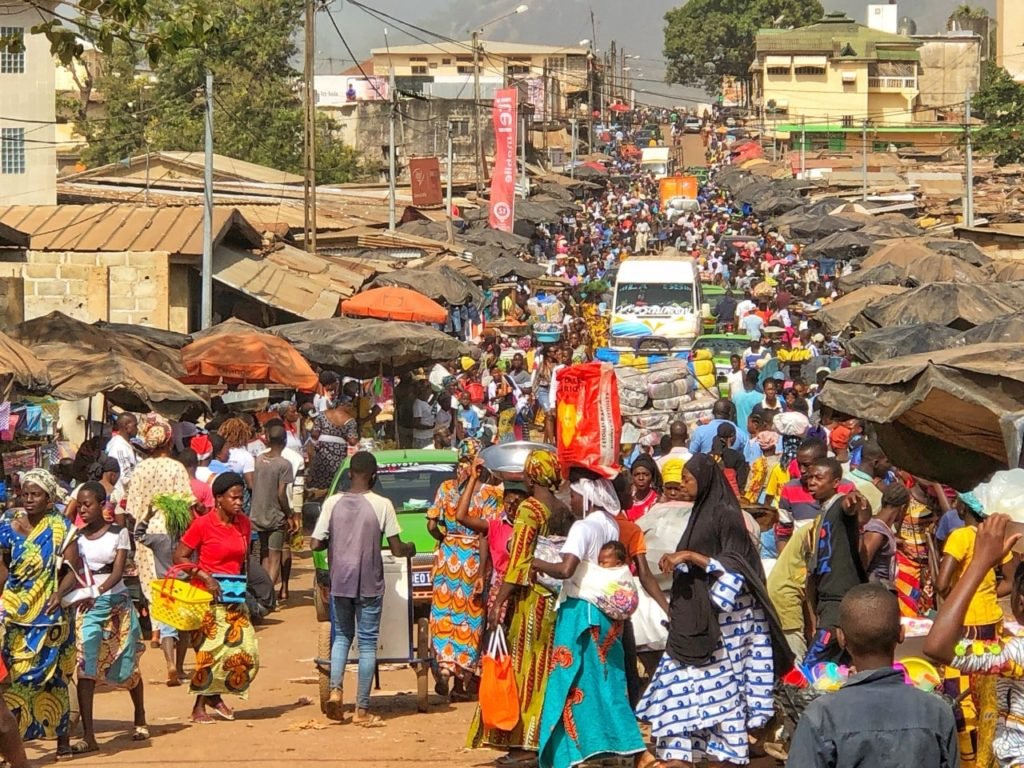
The Basics
Food
In the city centre especially along Rue de Commerce, there are bakeries selling baguettes, cake, and pain au chocolat. There is also a lot of great streetfood available at little stalls (called maquis) in the same area. The restaurant at Hotel des Cascades is pretty good.
Beds
We stayed at Hotel des Cascades, which has horrible staff but good rooms, nice pool, good restaurant and great views from up on the hill. That cost 35 000 CFA/60 USD for the cheapest room in the back, with an extra 3500 CFA/6 USD for breakfast. We stayed a night at Hotel Amotrin as well but it no longer has a working pool or restaurant and at the time we were there there was no running water.
Transport
Green shared-taxis run set routes around town. A seat is 100 or 200 CFA – ‘cent franc’ or ‘deux cent franc’/0.25 USD. Tell the driver a landmark or intersection where you want to get out. Agreeing to pay for all the seats, so around 1000 CFA (mille franc) gets you a private taxi. Expect some haggling.
Money
There are a couple of banks with ATMs in Man.
Yammasoukro
This quiet little city of 200,000 people is the capital of the Ivory Coast, with a cute nickname: Yakro. The Basilique de Notre Dame de la Paix alone makes the city worth a visit.
How to Get From Man to Yammasoukro
UTB runs big, reliable air-con busses from the station near the market. Go to the station a day in advance and check the ‘schedule’ on the wall, to get an idea of departures and frequency. We went early on the day we wanted to depart, and got seats on the next leaving bus. The road to Yakro is pretty good and smooth enough. The trip cost 6100 CFA/10 USD each plus 500 CFA/1 USD each for the backpacks. As always, set off early: it’s a 7.5 hour trip. We ended up leaving Man at 9.30 am and arrived in Yakro at 5 pm.
Yammasoukro – Things to See and Do
- The grand Presidential Palace, commissioned by Felix Houphouet-Boigny, the first President of Cote d’Ivoire. The former President’s tomb is in the grounds, not that you can get anywhere near it.
- The man-made lake in front of the palace contains sacred crocodiles who lie around on the pavement next to the fences waiting for food. Sometimes the gendarmes feed them live chickens – apparently you can buy a chicken in the market and feed them yourself.
- The Basilique de Notre Dame de la Paix – the biggest basilica in the world, this creation of Houphouet-Boigny is quite the sight.
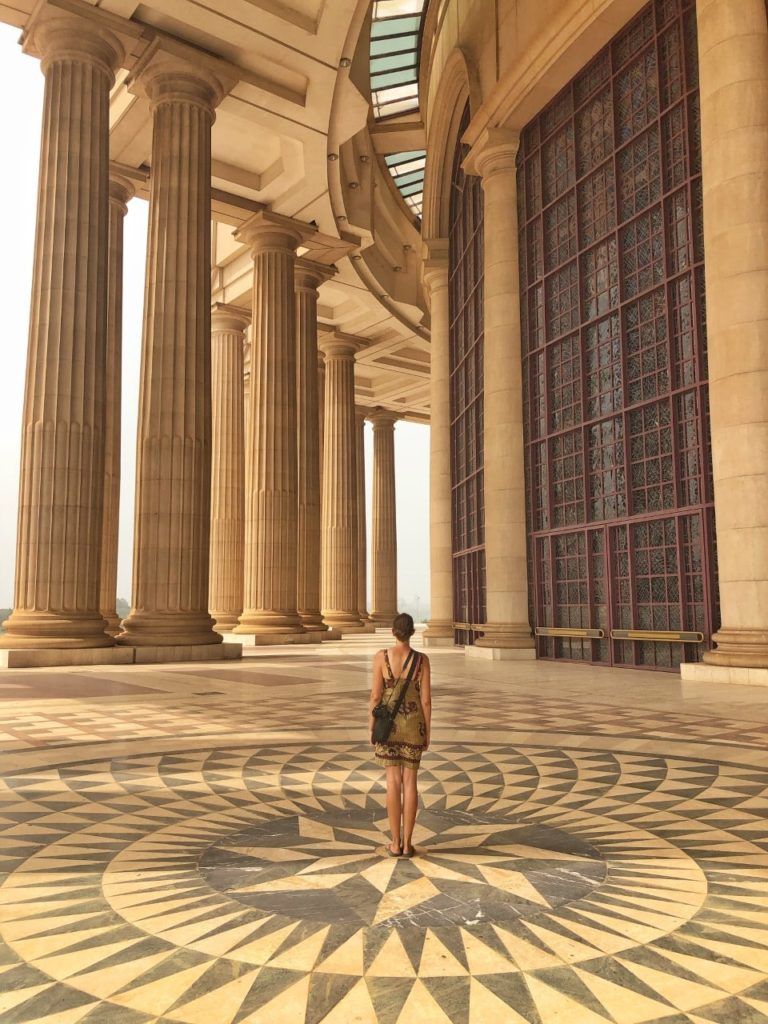
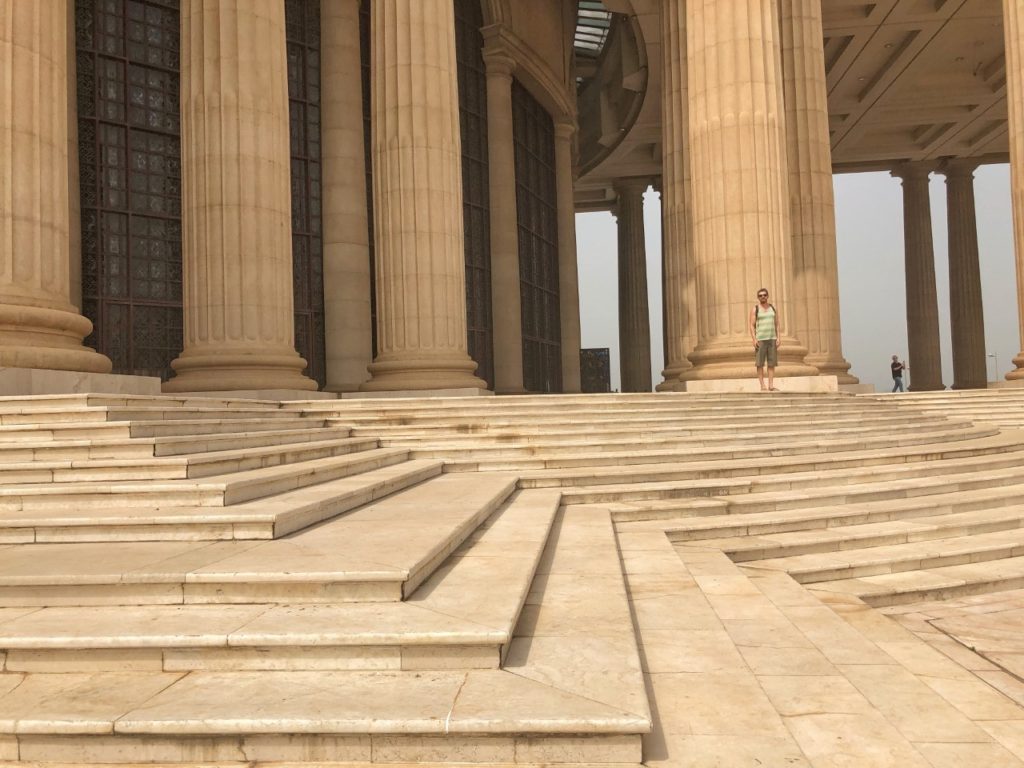
The Basics
Food
There’s a supermarket with a bakery in it right across from the the hotel I mention below (and a wine store beside it). There’s a good restaurant called La Brise a short walk from the hotel. It’s on the river with wifi, indoor/outdoor seating, Basilica views, and serves all meals all day.
Beds
We stayed at Hotel la Recidencia (which is much more basic than it sounds). Great central location, clean, and cheap – 20 000 CFA/35 USD for a double. The hotel has an attached restaurant and cafe where we never ate but they let us make coffee.
Transport
Yakro is easy and calm to walk around. White share-taxis run loops all over the city, with a seat costing 100 – 200 CFAs/0.25USD.
Money
There are a few ATMs in Yakro, including one directly across from Hotel La Recidencia. It always had a queue.
Abidjan
Not just ‘another big African city’. Oh, Abidjan is big, no doubt, but it somehow seems more comfortable and livable compared to a lot of its counterparts and less overwhelming to a casual visitor (to us, anyway). We rented an apartment and just spent a few days hanging out and exploring the neighborhood before moving on to Grand Bassam.
How to Get From Yammasoukro to Abidjan
Take a share-taxi to the UTB station in Yamoussoukro. Get a big bus from there to Abidjan. They are frequent, but as usual you should check the schedule the day before, and/or show up very early. We got tickets on the next departing bus quite easily – but waited forever for it to leave. It cost 4000 CFA/7USD plus 250 CFA/0.25 USD for luggage, each. It’s only 2 hours on a good road to the first stop near Abidjan, where you may have to change buses and wait (all on the same ticket but it’s a rush to get a seat and you’ll probably end up standing). Eventually this next bus will go another 45 minutes to the huge Adjame UTB station in Abidjan.
From Adjame, we took a taxi (private) to Deux Plateau for 2500 CFA/4 USD.
Abidjan – Things to See and Do
- Take a look around Plateau, the business district with skyscrapers and big hotels
- Visit St. Paul’s Cathedral – another one of former President Houphouet-Boigny’s fancy projects, with interesting stained glass windows.
- Go to Abidjan Zoo in the Deux Plateau area.
- Eat at one or two of the good restaurants.
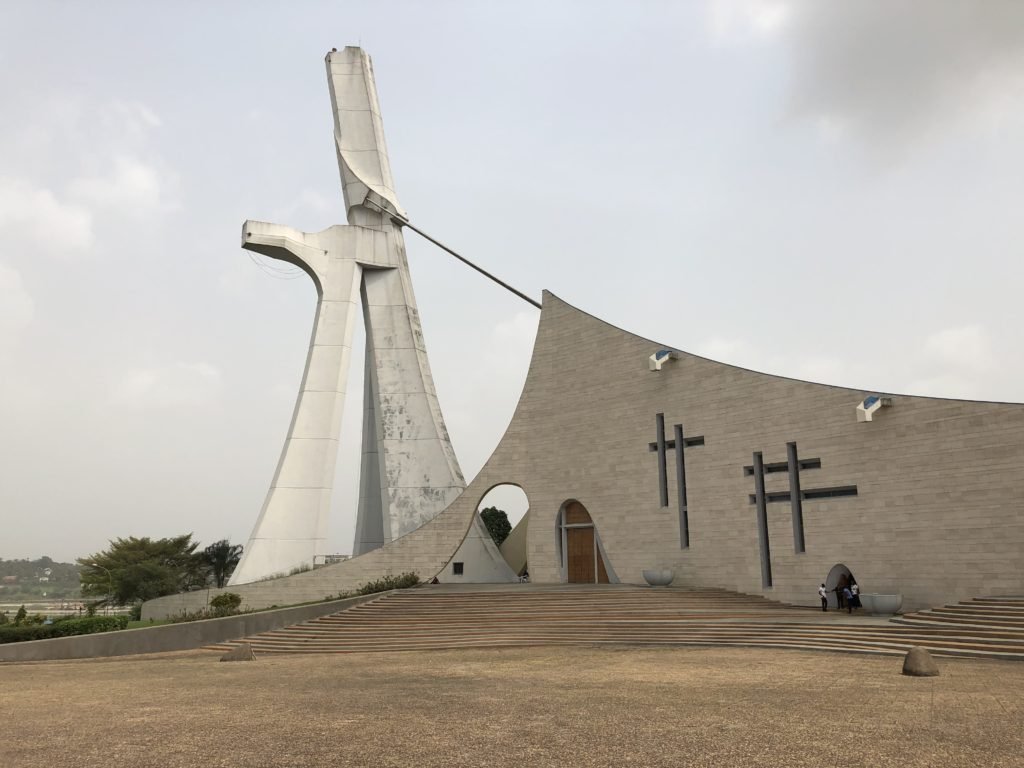
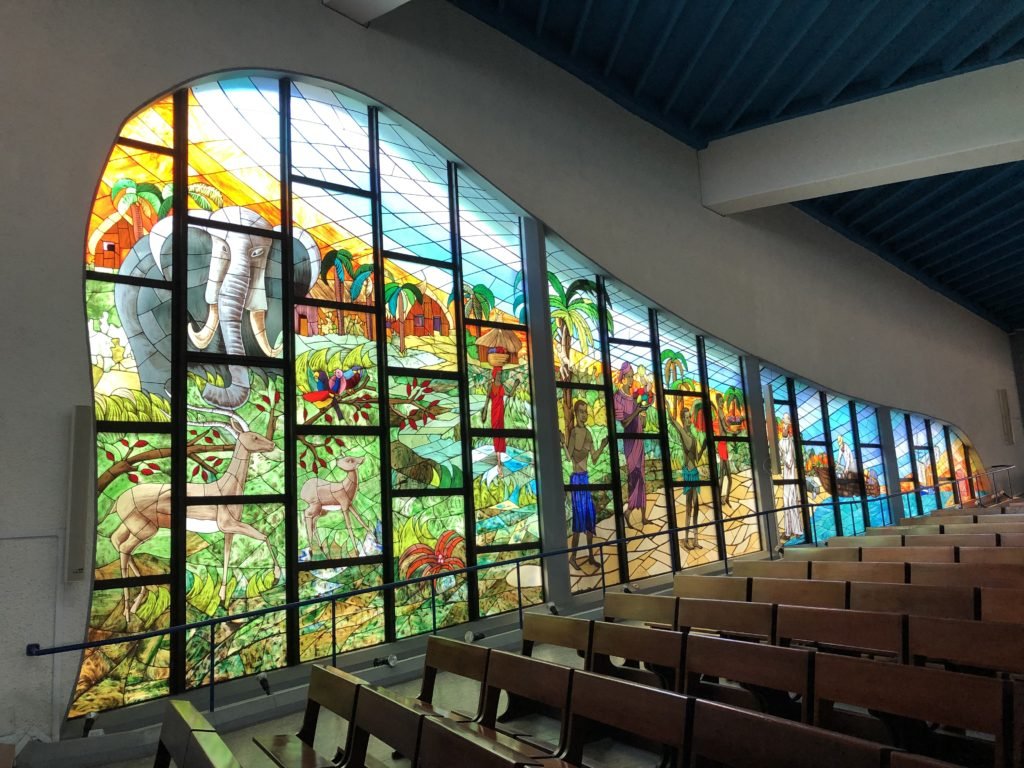
The Basics
Food
There was plenty of really good street food near our place in Deux Plateau, a huge hypermart near the zoo, and a King Cash and other smaller supermarkets walkable anywhere.
Beds
We stayed at Recidence Sonogo in Deux Plateau. It’s a self-contained service apartment. These are common, there are many on Booking.com. It cost 20 000 CFA/35 USD per night for an air-conditioned one bedroom apartment with kitchen, living room, private bathroom. It’s a busy, lively neighborhood full of delicious streetfood (maquis), open-air bars, and markets.
Transport
A short share-taxi ride should be around 250 CFA/0.25 USD per seat. Orange taxis are shared, yellow are private. Haggle the price first on a private taxi – within the city it should be around 1500-2500 CFA/2.5-4.5 USD.
Money
There are ATMs in the airport, malls, supermarkets, banks and upmarket hotels.
Grand Bassam
Grand Bassam: atmospheric French colonial ruins sandwiched between a long strip of golden beach, and a busy modern-day town centre.
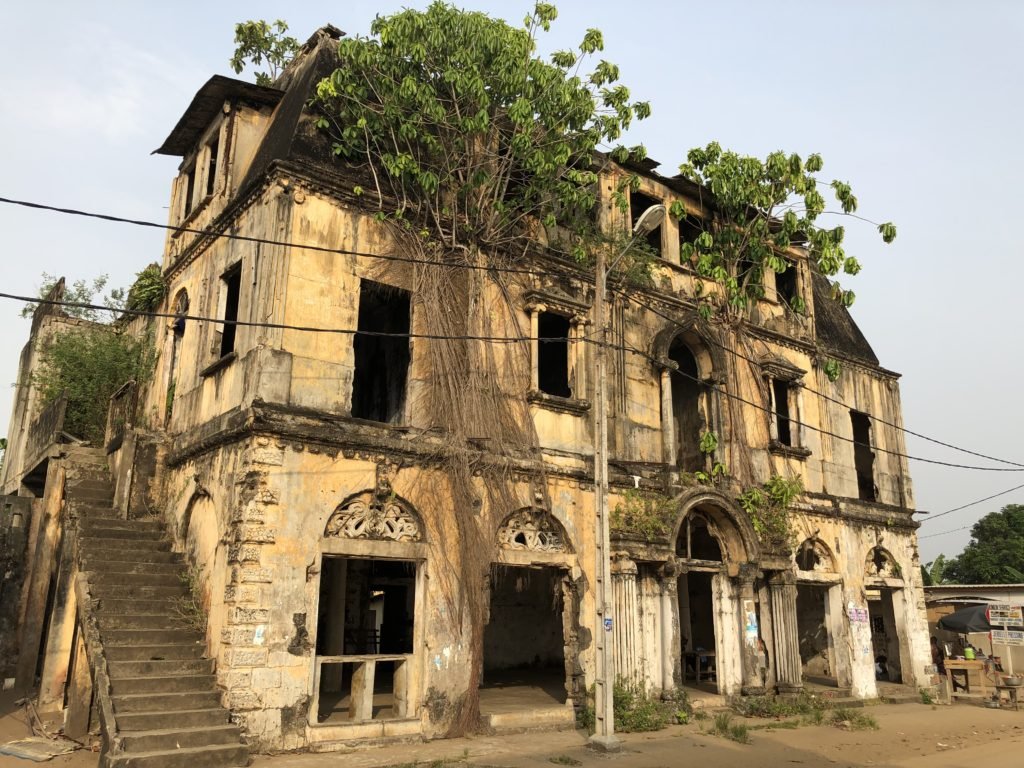
How to Get From Abidjan to Grand Bassam
Although busses run frequently from every station in Abidjan to Grand Bassam, the easiest way is to just flag a taxi (private, not shared) and agree on a price to Grand Bassam. We got a ride easily from Deux Plateau for 12 000 CFA/20 USD. It took a little more than an hour.
Getting to the Airport
If you’re going to (or coming from) the airport, Grand Bassam is a great stop on the way. If you want to skip Abidjan altogether, you can stay in Grand Bassam instead. You can ask your hotel to arrange a taxi to the airport but bear in mind this will cost about double what it costs to organise a taxi yourself in advance directly with a driver. We paid 10 000 CFA/17 USD organising directly (versus the offer from our hotel which was more than double that. However, if you’re going in the middle of the night, organising with your hotel might be a better idea).
Grand Bassam – Things to See and Do
- Way out on the edge of town past the Place de la Paix is a souvenir/handicrafts market that stretches along the road on both sides for ages.
- Check out the main market in central Bassam (over the Victory Bridge from the beach).
- Explore the crumbling ruins and abandoned buildings of the UNESCO Quartier Colonial: there’s a post office, the Governor’s mansion, the first bank, and a once-grand hotel, among others. They are mostly strung along Blvd. Treich-Laplene.
- Hang out at the beach – but swimming here is dangerous.
- There’s a memorial in the Quartier Colonial for the victims of the beachfront terror attack in 2016.
- Relax! Enjoy your beach hotel and good food….be on a ‘normal’ holiday for once.
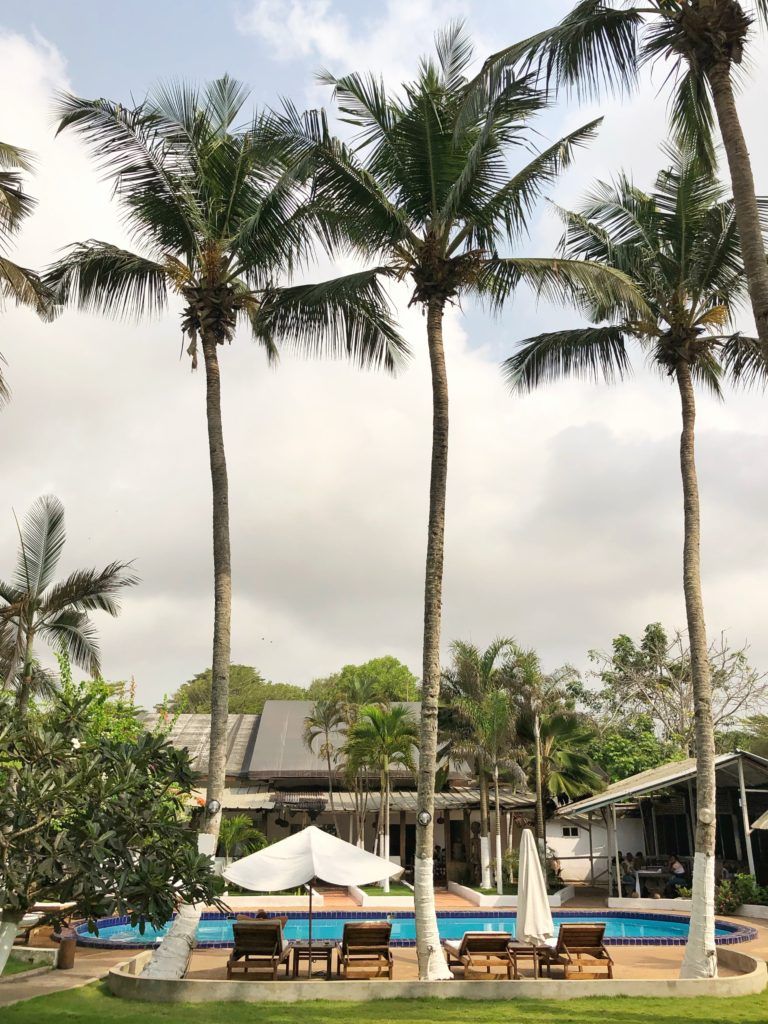
The Basics
Food
There are several good restaurants in the Quartier Colonial around the hotels. Le Mouton does great pizza, pasta, desserts, and local food too. There are bars and cafes along the lagoon, restaurants at the hotels, and maquis in the streets for cheap eats and beers.
Beds
I’d say the best hotel there is Koral Beach Hotel. It’s got a lovely pool area, nice rooms, big airy lounge and serves amazing breakfasts. All the good hotels are beachfront. The hotels in the city centre (across Victory Bridge) are nothing special and far from the beach.
Transport
To get across the bridge and into the city centre, jump in and out of red shared taxis for 1-200 CFA/0.25 USD per seat. Taking a taxi privately inside the city would be around 1000 – 1500 CFA/2-2.5 USD.
Money
There is an ATM near Place de la Paix across the bridge in central Bassam. Expect queues.
Packing List
Ivory Coast is the sort of place where it’s better to come prepared. In addition to season-appropriate clothing, here are a few things you should bring:
- bug spray, malaria tablets and a mosquito net. Malaria is not something you want to get and healthcare is not good.
- USD. Bring at least a couple of hundred dollars with you to get you started. You can change it to local CFA as needed, and withdraw CFA from ATMs as you go.
- Sunscreen. It can be hard to find.
- a flashlight for regular power outages and blackouts
- a couple of different-sized padlocks – to put on your bag before travelling with it, or to lock your bag when you’re leaving it behind in the room.
- a couple of powerbanks.
- Maps.me. Download the map for Ivory Coast to your phone in advance.
- Google translate with a French dictionary. And learn a few French words, at least the numbers.
- get the yellow fever vaccination if you don’t already have it, and bring the certificate and your vaccination records with you.
- copies of your passport. These are always useful to carry on you for checkpoints, in case of losing your original, and if you are going to be applying for onward visas along the way.
- a motorcycle helmet. Either that, or stay off the motos.
- a wine opener. Don’t laugh, I’m serious. You can find wine in supermarkets but every hotel we stayed at took it personally if we asked to borrow a corkscrew and wouldn’t let us – even just to have a drink in our room.
Read More
To get a real sense of the adventures (and misadventures) to be had in Ivory Coast, check out my stories from the road.




This Post Has 3 Comments
Thank you for your very informative blog. It gave me a lot of ideas on what to expect.
You’re welcome! Hope it helps:)
I lived in Cocody (just outside of Abidjan) for four years as a kid. Loved it. Very fond memories.